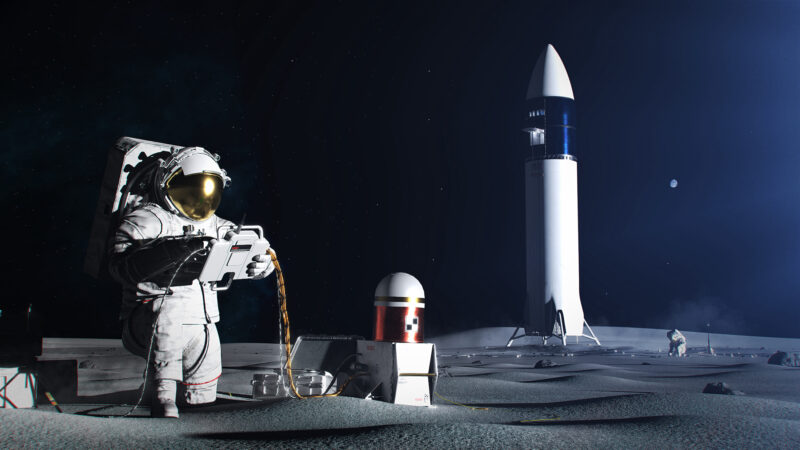
Perhaps the most frequent topic of conversation for the lunar exploration community is when American astronauts will return to the Moon. NASA originally aimed to land the first woman and next man on the Moon by 2024, but that date was pushed back repeatedly to September of 2026 at the earliest. The largest source of uncertainty in the schedule is SpaceX’s ambitious Starship Human Landing System (HLS), which NASA selected to ferry astronauts between the Orion crew vehicle and the lunar south pole. While the HLS team is making progress with the development of Starship, Elon Musk recently disclosed a serious issue with the current iteration of the vehicle. Starship is facing a 50% underperformance in terms of the payload which it can deliver to orbit. If this issue is not rectified, it could have grave implications for Starship’s ability to complete a lunar mission.
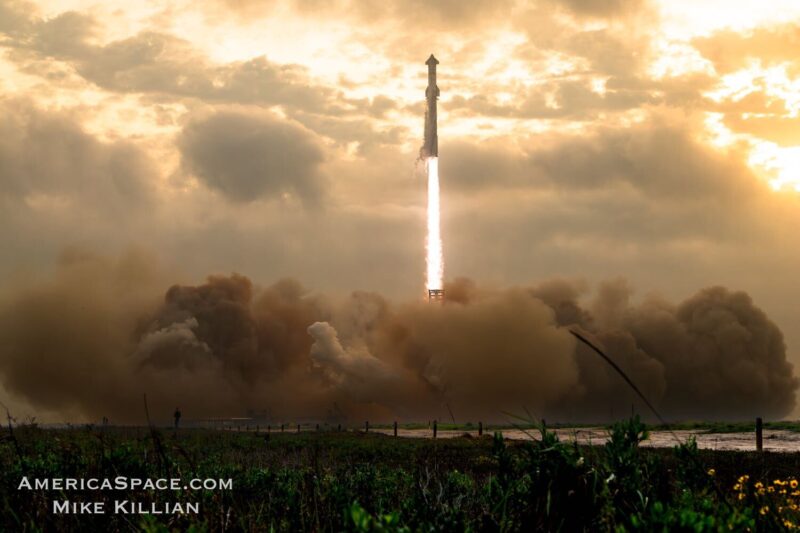
NASA understood that it was accepting a degree of risk when it selected Starship as the solitary lunar lander design for Artemis 3 and 4. In the HLS Source Selection Statement, Kathy Lueders, the former leader of the defunct Human Exploration and Operations Mission Directorate, wrote, “I acknowledge the immense complexity and heightened risk associated with the very high number of events required to execute the front end of SpaceX’s mission, and this complexity largely translates into increased risk of operational schedule delays” [1]. However, the only alternatives were an overweight Dynetics lander and a Blue Origin lander which would need a substantial redesign to achieve NASA’s long-term goal of landing four astronauts on the Moon. In this context, Starship had significant upside, as it far exceeded the HLS performance requirements. SpaceX claimed that it could deliver 100 tons of cargo to the lunar surface, which would reduce the operating costs of the Artemis Base Camp. In addition, SpaceX’s $2.9 billion bid was half the price of its competitors’ landers, since the company could offset Starship’s development cost by also utilizing it to launch satellites.
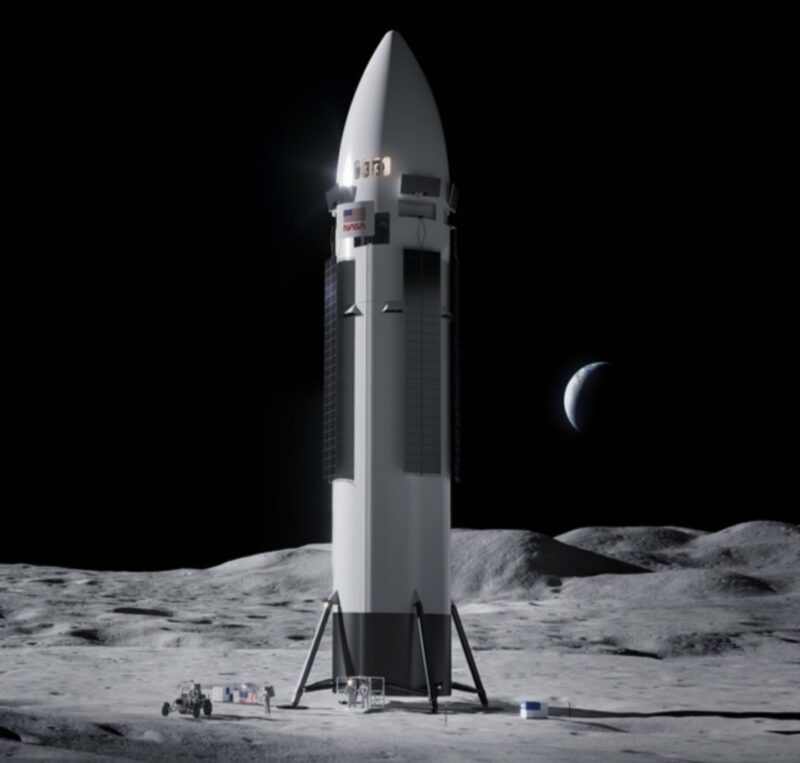
Over the past year, SpaceX and NASA have made noteworthy progress with the development of HLS Starship. After two failed test flights in April and November of 2023, Starship successfully reached orbital velocity on March 14th. It became the most powerful rocket to ever reach this milestone. The flight wasn’t perfect; the reaction control system’s thrusters were unable to control Starship’s attitude in orbit, and it burned up during reentry (although not before capturing spectacular video footage). The three test flights demonstrate that SpaceX is learning dozens of lessons from each mission and gradually improving the rocket’s reliability. In February, NASA and SpaceX completed over 200 tests of the docking system which will mate HLS Starship to Orion in lunar orbit. Leaked renderings, which AmericaSpace analyzed last December, demonstrate that the HLS team is factoring all of these test results into a more robust and capable design for the lander. However, its ability to reach the Moon in the first place was cast into doubt by an announcement which took place two weeks ago.
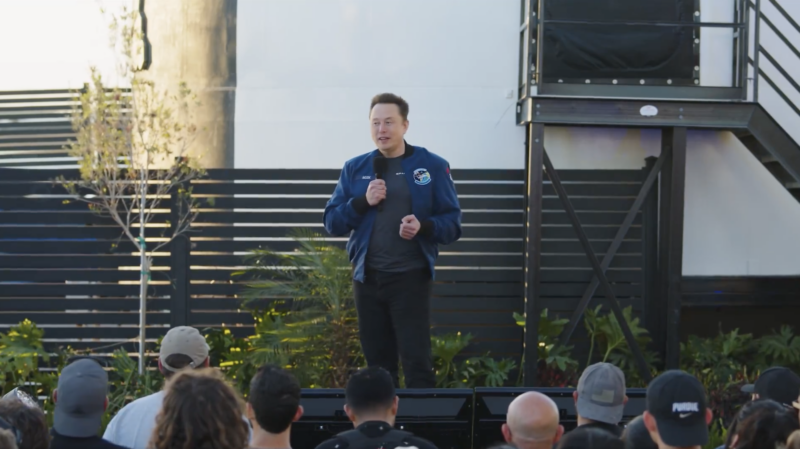
On April 4th, SpaceX CEO Elon Musk provided a public update on the Starship program from his company’s facility in Boca Chica, Texas [2]. This was not a novel event; Musk gives an in-depth presentation on Starship on a roughly annual basis. He provided ample discussion on his visionary goal of establishing a colony on Mars. Spaceflight media outlets offered glowing commentary on his claimed goals for Starship’s marginal launch cost and payload to orbit. In reality, the most important announcement was arguably contained within one sentence:
“Currently, Flight 3 would be around 40-50 tons to orbit.”
To understand the significance of this statement, one only needs to review prior statements about Starship’s performance. Ever since Musk’s 2017 presentation, Starship’s estimated payload capacity has ranged between 100 and 150 tons to Low Earth Orbit (LEO). SpaceX’s official Starship Payload Users Guide clearly states that “At the baseline reusable design, Starship can deliver over 100 metric tons to LEO” [3]. For the past six years, Starship’s diameter, height, and propellant mixture have remained constant. The most straightforward interpretation of Musk’s comment is that the rocket is suffering from a 50% underperformance.
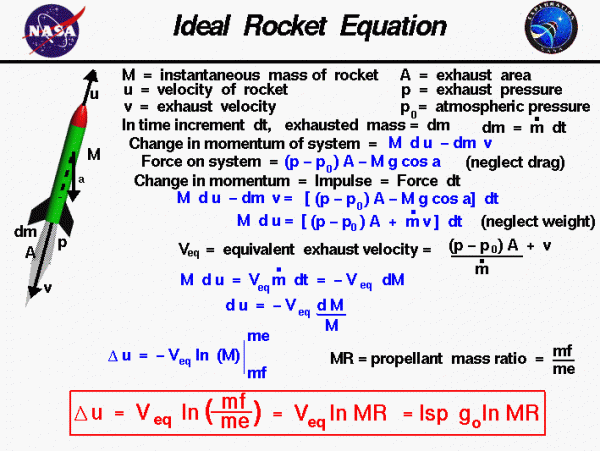
The potential causes of Starship’s performance shortfall can be understood using Russian physicist Konstantin Tsiolkovsky’s famous Rocket Equation [4]. This formula is complex, but in essence, it relates a rocket’s payload capacity to its mass and its efficiency (specific impulse). Tsiolkovsky illustrated why launching a payload into orbit is an unforgiving challenge. If the mass of a rocket’s upper stage grows, this must come at the expense of its payload since both elements are placed into orbit together. An increase in the mass of the first stage has a less draconian impact, but it still will cut into the payload capacity.

This is likely what happened to Starship. To mitigate the risk that one exploding Raptor engine might cause a cascade of failures, SpaceX installed extra shielding around each of the 33 motors on the Super Heavy booster. In addition, it installed a steel “hot staging” ring between the booster and the ship, which allows the latter to ignite its engines while the two stages are still attached. It is worth noting that this component was supposed to increase the performance of the vehicle by 10%; SpaceX has not disclosed whether those gains were realized. Other additions to the vehicle included components which mitigated the propellant leaks which partially contributed to the failure of the first test flight. Each additional gram of mass ate into Starship’s payload capacity.
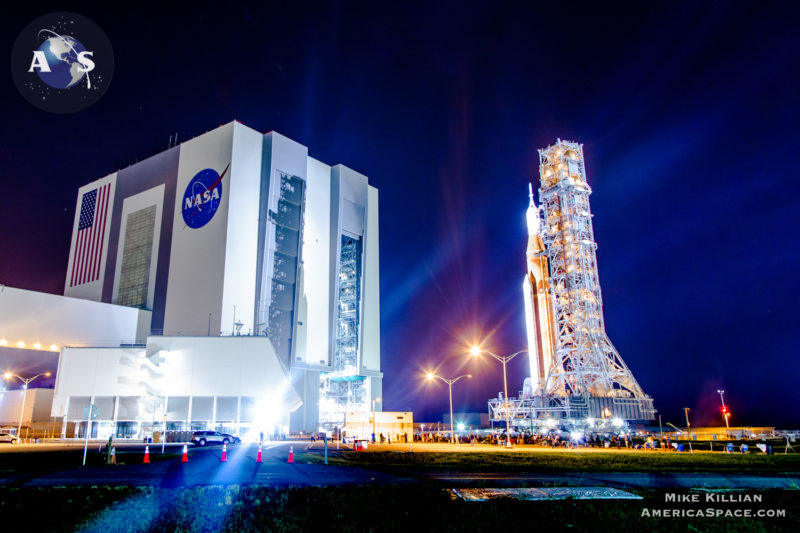
To be fair, 40-50 tons is still an impressive payload mass. Among operational rockets, it is only exceeded by NASA’s Space Launch System (SLS) and SpaceX’s own Falcon Heavy. With the current design of Starship, SpaceX should be able to deploy the next generation of satellites in its Starlink constellation. However, from a national perspective, Starship’s most important purpose is not launching satellites, nor is it colonizing Mars. The Artemis program is arguably the most ambitious and important human spaceflight program since Apollo, and NASA is entirely reliant upon Starship if it wants to land its astronauts on the Moon by the end of the decade.

The success or failure of the Human Landing System program will be decided by Starship’s payload capacity. Due to its high dry (unfueled) mass, Starship HLS cannot reach the Moon without first refueling in LEO. To complete the Artemis 3 mission, SpaceX must therefore implement orbital refueling on an unprecedented scale. Even on Earth, loading cryogenic propellants into a launch vehicle is no easy feat; if anything, this will be more difficult in space. Prior to every Artemis mission, a flotilla of reusable Starship tankers will transfer liquid oxygen and liquid methane to an orbiting propellant depot. The lunar lander will then launch, receive a full load of fuel and oxidizer from the depot, and continue onwards to the Moon.

The number of tanker flights which will be required to complete Artemis 3 is hotly debated. Estimates range from four [5] to nineteen [6] launches of propellant per lunar landing. Former NASA Administrator Mike Griffin recently noted that the probability of mission success is directly correlated with the number of launches in each refueling campaign [7]. For instance, it is reasonable to assume that each individual Starship launch, plus the subsequent propellant transfer operation, will have a 98% probability of success once the procedure is refined. If five tanker flights are required, the mission as a whole will succeed in 90% of scenarios. In contrast, if twenty launches are needed, that probability drops to just 67%.
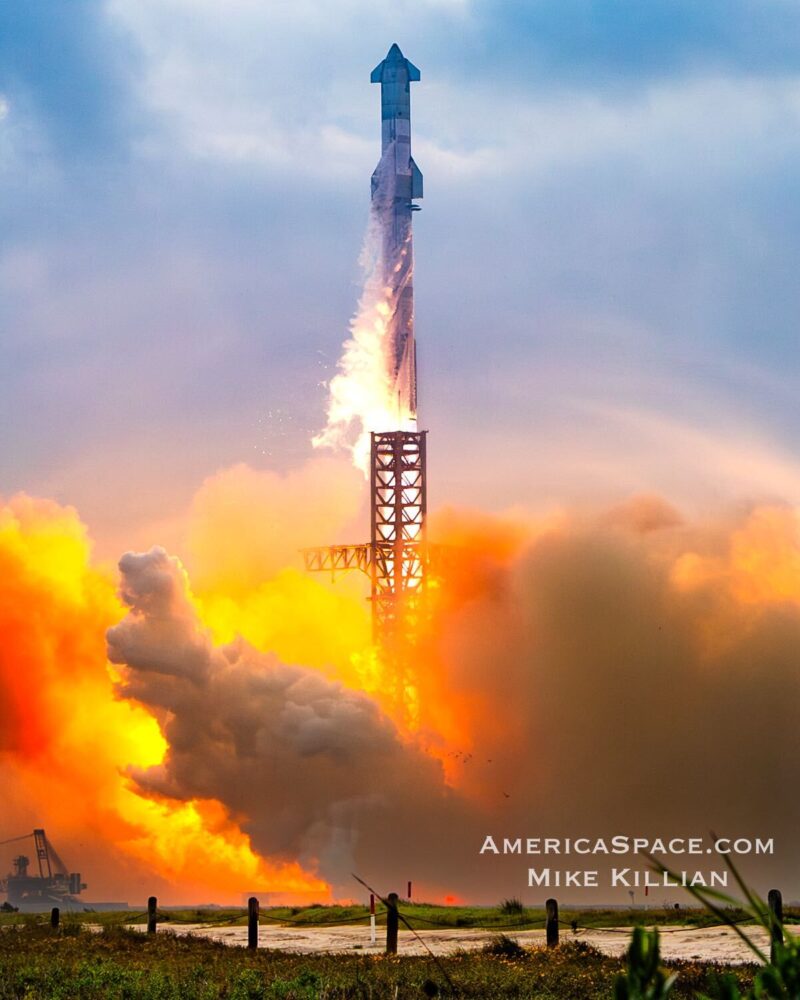
The precise number of tanker flights depends on several variables, including the Starship launch rate and the rate at which cryogenic propellant boils off to space while the depot is in orbit. However, no parameter is more important than the vehicle’s payload capacity. If Starship’s payload mass grows, the number of tanker flights required to complete an Artemis mission will decrease. Conversely, a reduction in payload capacity will increase the number of propellant launches.
The current iteration of Starship can store 1,200 tons of liquid methane and liquid oxygen in its propellant tanks. Recent renderings suggest that the lunar lander will be slightly taller, with a propellant load of approximately 1,500 tons. If each tanker can deliver 100 tons of fuel to orbit as advertised, then it will take 15 flights to complete an Artemis mission. This number is large, but given SpaceX’s demonstrated ability to scale up to a high cadence of missions, it is not insurmountable in medium- to long-term timeframes.
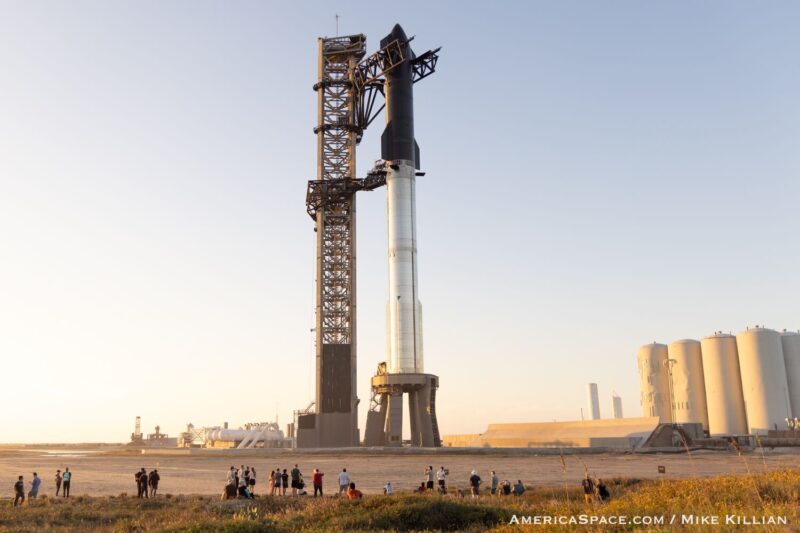
However, if SpaceX is only able to launch 50 tons of propellant to orbit inside each Starship tanker, then it will need to launch the world’s largest rocket a staggering 30 times to refuel a single lunar lander. Two additional launches will be required to place the Starship HLS and the propellant depot into orbit. To make matters worse, this hypothetical manifest does not take boiloff into account. Even if NASA and SpaceX achieve their stated goal of a 6-day turnaround between Starship launches, it will take over half a year to stage all of the propellant in orbit. Several additional flights might be required to replace the oxygen and methane which are lost during this time period.
Even for talented organizations such as SpaceX and NASA, executing a coordinated campaign of 32+ flights seems costly and unsustainable at best, and infeasible at worst. To extrapolate Griffin’s calculation, it would only have a 52% probability of success even if attempted. Musk’s statement that Starship can only place 40-50 tons into orbit leaves little room for vacillation. If Starship’s payload capacity does not increase, it is likely a showstopper for the Artemis program.

With all this being said, supporters of lunar exploration should not despair. Iterative development is a key tenant of SpaceX’s organizational philosophy, and the company’s history demonstrates that the capabilities of its vehicles often improve over time. Its workhorse Falcon 9 booster has undergone five major block upgrades. The original Falcon 9 was 157 feet tall, and it could deliver 10.4 tons of cargo to LEO. The current Block 5 booster features upgraded engines, a reinforced thrust structure, stretched fuel tanks, and landing legs to enable reusability. Over the course of a decade, Falcon 9’s height increased by 73 feet, while its payload grew by a factor of two.
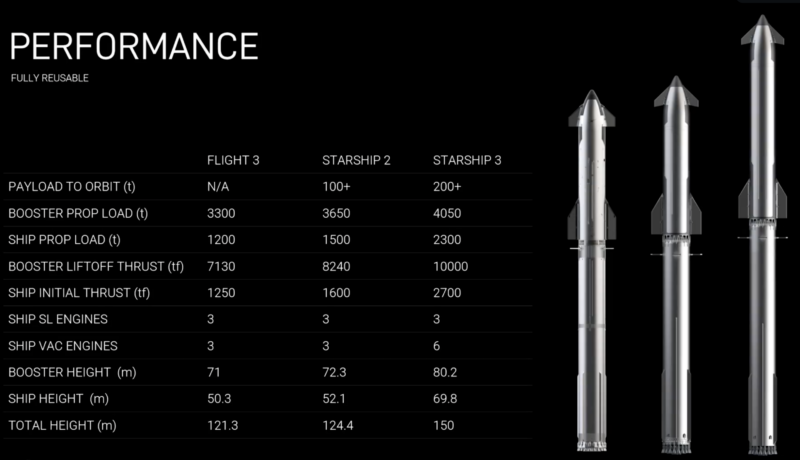
SpaceX intends to follow a similar model to move a lunar mission back into the realm of feasibility. During the same address, Musk stated that his company is already designing an upgraded “Starship 2.” Both stages of the rocket be slightly longer than their existing counterparts. The ship will be stretched by six feet (1.8 meters); coincidentally, that would make its height equal to that of the latest design for Starship HLS. Starship 2 will also feature the improved Raptor 3 engine and a new hot staging ring to reduce damage to the booster during stage separation. Musk said that it should be able to place 100 tons into orbit, which would restore Starship’s intended payload capacity.
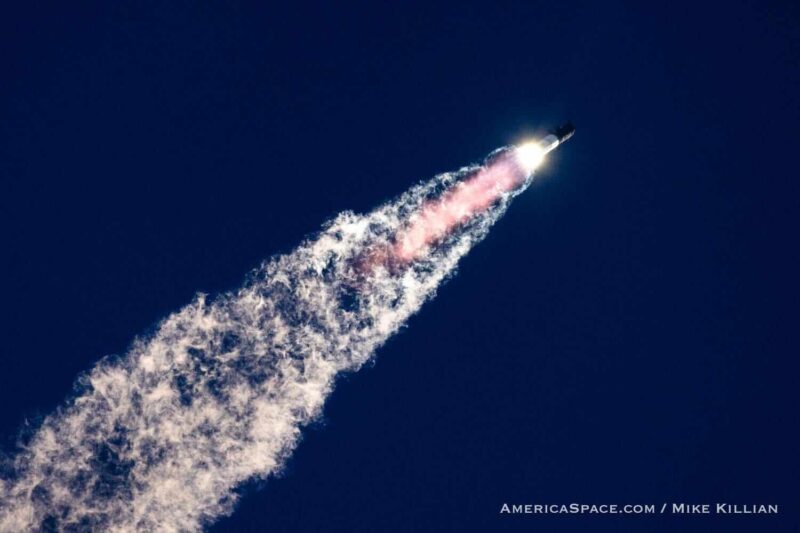
Starship 2 will eventually be supplemented or replaced by the ungainly-looking Starship 3. This launcher’s ship and booster will both be substantially stretched. The complete stack will be a staggering 492 feet (150 meters) tall. The Raptor engines will receive yet another performance upgrade. According to Musk, Starship 3 will have a payload capacity of 200 tons to orbit. This capability would enable it to refuel a Starship HLS with only eight tanker launches.
It is worth noting that Starship 2 and Starship 3 are not immune to the current design’s issues with parasitic mass. If the vehicles need to be reinforced to rectify issues discovered during test flights, they may not achieve their performance targets.
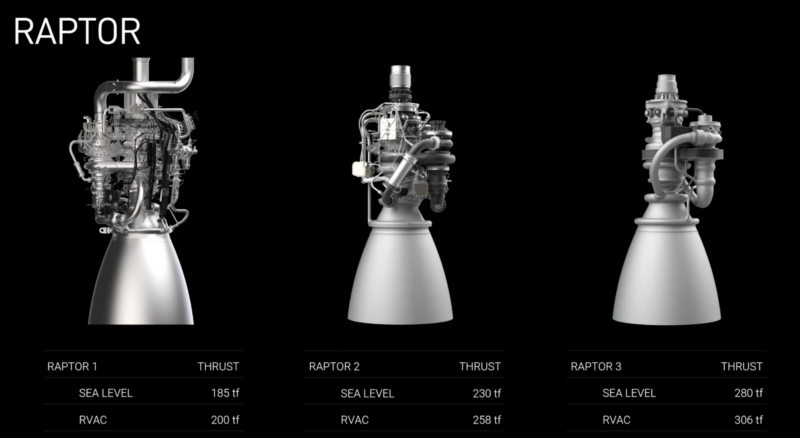
To lift these behemoths off the launch pad, SpaceX will also need to install a more powerful engine on the Super Heavy booster. The Raptor 3 will produce 22% more thrust than the Raptor 2 engine which propelled the first three flights of Starship. “Raptor 3 looks very simple,” said Musk. “A lot of the complexity is hidden, because we have integral cooling channels in many parts of the engine that don’t exist in Raptor 2. In order to not have a heat shield, it has to be very resilient.” Raptor 3 entered testing last May.
SpaceX’s roadmap for increasingly capable Starship variants hinges on the success of the new engine. This might explain why the Government Accountability Office (GAO) listed the development of Raptor as one of Starship HLS’ two largest technical hurdles, alongside orbital refueling, last November [8]. “In a February 2023 interview, HLS officials said that if the Raptor engine operates below performance levels needed to meet mission requirements, thereby delaying engine certification, then it is possible that the new main engine for the Human Landing System will not be ready to support the planned mission in December 2025.” (After the report was issued, Artemis 3’s launch date was delayed by nine months.)
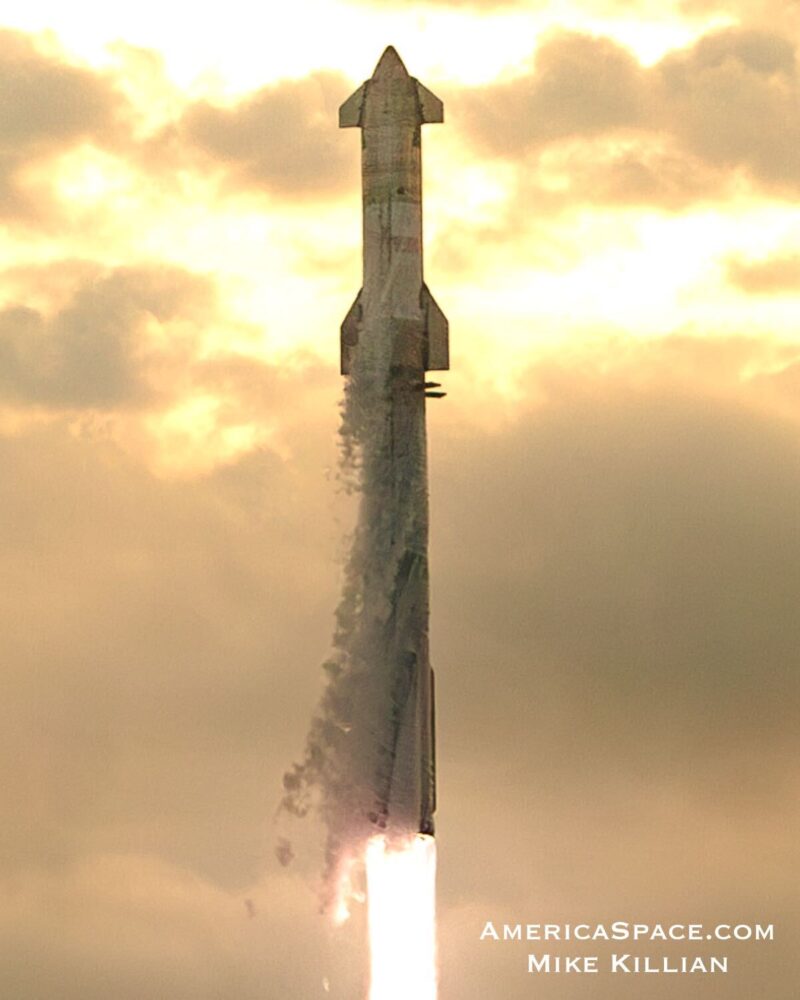
It is currently unclear when Starship 2 and 3 will enter service. After IFT-3, three more examples of the original Starship design remain in SpaceX’s inventory [9]. The improved variants will likely debut after the existing prototypes fly. Media outlets such as NASASpaceflight [10] and Lab Padre [11] monitor SpaceX’s Boca Chica production facility around the clock. As of this writing, their cameras have not conclusively identified any Starship 2 parts. Therefore, the first upgraded ship will likely not fly until late this year or early next year. Starship 3 likely lies farther in the future, as the performance metrics which Musk presented indicate that it will require yet another engine upgrade beyond Raptor 3. SpaceX did not respond to a request for comment on when Starship 2 and 3 will enter service.

NASA still maintains that Artemis astronauts will land on the Moon by the end of 2026. However, in January, Musk acknowledged that this milestone might not happen for up to five years [12]. While it is not necessarily fatal for the program, Starship’s performance shortfall provides additional evidence that the Artemis schedule will likely continue to slip. Musk’s prediction that the next crewed lunar landing will not happen until the end of the decade may be more accurate than not.






The empty weight of SLS is 188,000 pounds
Starship empty weight is 220,000 pounds.
Suppose we had SLS and air-start RS-25s
What payload does that give you now?
Apart from the RS-25s being unable to air-start (without a billion $ development contract)
what are you actually suggesting ? Some combination of SLS stages and Starship stages ?
And for what purpose ? filling an orbital depot, or landing on the moon ?
Hi Jeff,
I am a bit confused about what you are suggesting. Are you proposing to put an HLS Starship on top of an SLS core stage and boosters, or to put something like the SLS Exploration Upper Stage (EUS) on top of an expendable Starship stack?
My guess is that the former would be infeasible due to the high fueled mass of HLS Starship (~1700 tons), plus the low flight rate and high cost of the SLS. However, the latter would theoretically be able to send a sizable payload to TLI (though you would want the higher performance of Starship 2 and 3 to place the EUS and payload in LEO).
This article seems part of a campaign to cast shadow on SpaceX and blame them for delays to Artemis. Whereas Artemis 3 was primarily delayed by Artemis 2 being delayed by unresolved issues with the Orion spacecraft for the crew.
Current versions of Starship are prototypes. There are only 3 or 4 of version 1 left before SpaceX fly version 2 – so we should see version 2 flying before the end of 2024.
Hi Rodney,
Nobody has ever accused me of being part of a conspiracy before, so part of me is flattered to be ascribed such a devious agenda! With that being said, I reassure you that nothing of that sort is happening here. I have never met Mike Griffin before, though I admit that he raises some fair points about Artemis’ ability to safely land crew within a reasonable time horizon. With this article, I was just trying to explore the potential implications of a noteworthy statement in Musk’s speech which the mainstream media failed to cover.
One minor nitpick: During the press conference in January, the NASA panelists emphasized that Artemis 3 would have been delayed regardless of the schedule for Artemis 2 due to issues with HLS Starship and the Axiom Space EVA suits. I recommend that you listen to the recording if you don’t take my word for it.
On to your second comment. There is some truth to your statement about distributed launch, as long as the vehicle is lost during ascent or EDL. However, the failure of a launch vehicle is typically followed by a multi-month stand-down to determine and rectify the cause of the anomaly. During that period, any propellant in the depot would be susceptible to boil-off, so you would need additional tanker launches to replenish it. The benefits which you cite also do not apply to a failure during the refueling operation which damages the depot. If that happens, you need to restart the refueling campaign.
Hi Alex, Thanks for responding.
Mike Griffin said to a Congressional committee, IIRC that USA should not use Starship for Artemis and should use government owned vehicles instead. All his other comments I interpret in that light.
During the January press conference on the delays to Artemis 2 and 3, it came across as NASA needed to delay Artemis 2 because of the issues with Orion, so they mentioned Starship and the Axiom space suits for Artemis 3 as a distraction from Orion. “Safety” was their top priority, so they can use more-testing-needed for future delays. They gave the impression that delays were business-as-usual.
I get the impression that Blue Origin, and some in NASA, would be happy to say Starship won’t be safe or on time for Artemis 3 so lets drop it and wait for the Blue Origin lander being developed for Artemis 5.
Yes, after a launch failure there is almost always a long delay for investigation. I hope that knee jerk reaction can be modified for reusable launch vehicles. eg. if a vehicle fails on its 20th launch, do new or fairly new vehicles need to be stood down ? Or, if a new vehicle fails on its first launch, do proven vehicles need to be stood down ? And, as we have seen with Falcon 9, reusable vehicles can be extremely reliable once in high cadence operation. And the reuse allows plenty of practice of transferring propellant to a depot. So all the hand wringing by Mike Griffins about the risk of multiple launches seems overdone.
Sad BTW that the commenting facility on this website (unlike most others) does not seem to allow minor corrections to recent comments.
Rodney,
In reading and watching his congressional testimony January 17th, I didn’t get the impression that Griffin “hated” Starship. Instead, what he disliked are decisions made by those no longer within NASA in an efforts to return to the Moon, HLS contractors who are promising a capability to land astronauts on the Moon knowing full well that the likelihood of meeting that challenge by promised dates is very low to zero, all of which means that there is a real non-zero chance that China could beat us to the Moon.
Let’s begin with one point Griffin challenged in his January testimony; NASA’s choice of a NRHO, which has a period of 6.5 days. As he testified,
“If a lunar crew encounters a problem on the surface that mandates a return to the comparative safety of the Gateway, then depending upon when that problem occurs, a multi-day wait may be required. It is possible in some scenarios to wait in low lunar orbit (LLO), but access to the Gateway is only possible at periodic intervals.”
What Griffin didn’t mention is that such a stay could last far longer in some cases, such as if the landing crew are forced to make a “touch-and-go” landing, as NASA puts it, and need to remain in a quiescent state.
Regarding NASA’s choice of lunar lander requirements (see NASA’s Appendix H: Human Landing System, Attachment F, HUMAN LANDING SYSTEM (HLS) REQUIREMENTS DOCUMENT, HLS-RQMT-001 Document Rev-R (SRD), (Document Number HLS_RQMT-001) Griffin testified,
“Tactically, the selected mission architectures pose significant concerns. SpaceX’s approach requires an impractically large number of orbital refueling operations for even a single lunar mission, while Blue Origin’s mission design depends on the development of one of the most difficult enabling technologies for long-duration space flight, zero-boiloff cryogenic fuel storage.
These architectures feature concepts – cryogenic propellant storage, likely in large depots with low, controllable boiloff – that are critical to long-term, sustainable human space exploration. But while important, their development is unlikely to be completed easily or quickly, and over the last half-century we have used up the time that could have been devoted to the evolution of Apollo-era systems to a more sustainable architecture. Like it or not, we are engaged in a
competition with others who do not wish us well; timeliness maters.”
What Griffin is pointing out are issues with the Artemis architecture. He points out that none of the HLS landers can go to the Moon without some exotic capability not available today nor likely soon, and that pursuing those capabilities isn’t as important as reaching the Moon before our adversaries do. That isn’t “hating” Starship so much as pointing out obvious downsides to the HLS portion of the Artemis architecture and faced by both SpaceX and Blue Origin.
Regarding Starship in his testimony, Griffin offers a frequentist approach in analyzing the probability of a Starship lunar landing for a given range of required refueling missions and probability of those being successful. As you might recall from probability, each refueling mission is ideally an independent event. The total probability is the product of the individual probabilities. So, if 10 refueling launches are needed and if each has a (unrealistically high) reliability of 99%, then the total probability of success of those 10 missions is 90%. But, if the reliability of each refueling mission drops even a smidge, to say 97%, the total probability of 10 refueling missions drops to 74%; a drop to 95% means a total of just under 60%. I don’t think even the most diehard SpaceX fan can look at those numbers and feel comfortable at the overall mission risk.
Perhaps I’ve evolved too thick a skin having written on space matters over the last 16 years, but Griffin’s testimony regarding Starship doesn’t sound like “hate”, as you write, but well argued, darn hard to refute concerns.
To your point that some in NASA and Blue will be happy when, not if, it becomes unavoidable that Starship will not be ready for Artemis III? With all due respect Rodney, I don’t think most outside of NASA and its contractors realize that there is a zero chance SpaceX will be ready for Artemis III. Or IV. Even Elon admitted last January that SpaceX wouldn’t be ready to land astronauts on the Moon until 2028, and given his record, that likely means sometime in the 2030’s.
The important point is that there is a non-zero chance that we’re going to have a crewed lunar capable lander by 2028 (Elon’s words, not mine) or later. The most important point isn’t whose lander, whether SpaceX or Blue Origin, gets us to the Moon. The most important point, as laid-out by those paying for the Artemis program – that would be Congress – is that we get back to the Moon before our adversaries do.
And to be clear, Griffin made the case in his testimony that between NASA’s lunar architecture, its HLS office’s HLS requirements, the lander contractors, the lunar spacesuit contractors, things are looking bad.
Nobody wants the day of reckoning when it becomes unavoidable for Congress not to notice that NASA’s NRHO choice, the HLS program office’s decision to forbid any use of SLS to launch lunar landers, and the contractors may very well prevent the US from reaching the Moon first. But that day is coming, and likely the pieces will start falling after Artemis II lifts off.
Lastly, as concerns your point about, “…knee jerk reaction can be modified for reusable launch vehicles. eg. if a vehicle fails on its 20th launch, do new or fairly new vehicles need to be stood down ? Or, if a new vehicle fails on its first launch, do proven vehicles need to be stood down ?” Having been a pilot, I know that even long legacy systems can surprise. So, no, that “knee-jerk reaction” won’t, hopefully, ever go away. As Hans Mark, a former NASA Deputy Administrator and professor of mine, once said, “Americans don’t like it when you kill their astronauts.”
Another silly article written with an 8th grade level thinking. The problem of Apollo was it was a dead end technology once it landed on the Moon, planted a flag and grabbed a few rocks. It wasn’t going to support the building of a Moon base.
Way too many people think Artemis should be an re-enactment of Apollo with a tiny and very limited lander. NO, they are totally clueless and want to repeat the Apollo mistake. This time we need a system that can place 100’s to 1000’s of tons of equipment on the Moon.
Physics demands orbital refueling, like it or not. Economics also demands a fully reusable launch system. It is called living in reality. Starship is a Mars Transportation and Landing system NASA wants to use for the Moon. SX is going to take years to develop it properly. The Artemis III landing date was a politically driven in order keep SLS/Orion funded, to create political jobs. Congress never funded a lander and hopes SX bails the out with their Mars lander.
The reality of course, is once Starship is functional SLS/Orion has no purpose and the most of the Artemis architecture/hardware becomes obviously unnecessary and way too expensive. The limit of Congress’s vision in always the next election so Artemis makes sense politically. Also Congress will blame SX for the delayed Artemis III landings and will try to grab billions to fund another lander, more jobs in their districts.
Mike Griffin has made it clear that he hates Starship and SpaceX. His use of the table of probabilities is disingenuous. It might be relevant if every launch or propellant was accompanied by crew or irreplaceable hardware, but a failed propellant launch just requires another. There will be plenty of Starship hardware, and a few backup launch complexes.
“Distributed launch” makes the probability of success much higher. SLS or Starship may have a 2% chance of launch failure, but with 6 Starship launches you’ll have a 99.96% chance of 5 of them succeeding. (And 6 Starship stacks, even fully expended, are cheaper than one SLS stack).
If you need 10 Starship launches, plan on 11 or 12 to ensure success. (Doesn’t work with SLS that needs a year or two to build & launch each one.)
A few glaring errors, but despite asking leading questions casting doubt on SpaceX you later answer them, removing doubt and making the first half of the article worthless unless you are just trying to mislead people that won’t read the entire thing.
The lunar mission does NOT require a full tank of fuel, so do you trust spacex estimate, or Jeff bezos estimate, the guy who patented SpaceX drone ship to prevent SpaceX from using it and who spacex sued and won against, the guy that put out propaganda infographics that were demonstrably false, the guy who misquoted NASAs own report back to NASA and LIED to NASA about the risks associated with his lander and SpaceX lander. Would you believe the company with intimate knowledge of it’s own rocket and mission requirements, or a liar?
The current iteration of starship is just that, the current iteration in it’s development cycle, it’s current capability in no way reflects it’s future capability and it’s silly to suggest it won’t continue to improve as spacex has been doing. It’s just as silly to base your guesses on the first version of raptor which was far worse.
You claim hot staging which increases payload to orbit will instead decrease it.
You entirely ignore the 2,000,000$ launch cost because it’s fully reusable, even with your incorrect figures the total cost is 60 MILLION, SLS is 2 BILLION. SpaceX plans for this to be human rated with a success rate comparable to airlines. that 2% failure chance is for old space, not spacex with a higher success rate. The latest version of falcon 9 with a hundred flights has never had a single issue.
Many sources, but leaves out critical info and is clearly biased.
Hi Jessie,
I am sorry that you did not enjoy the article, but I stand by my work. I have been a supporter of SpaceX ever since I was 11 years old, and I have no bias against the company. As a lunar scientist, I am counting on them to be successful with HLS.
Even if it is resolved in a year or two, the Starship performance shortfall was worth writing about. It is part of the story of Artemis, and it is worth tracking if we want to have reasonable expectations about the program. To use a historical analogy: Should journalists have ignored the issues with the Block 1 Apollo command module, which led to the Apollo 1 tragedy, if they were resolved in the Block 2 upgrade? Should they have ignored the “pogo” oscillations which arose during Apollo 6 and caused a fair amount of consternation during the debate over whether to put crew on the next Saturn V during Apollo 8?
You say that the lunar mission does not require a full tank of propellant. Can you please cite evidence for that claim? Jessica Jensen’s recent statement that a lunar mission will require “10-ish” tanker flights seems to support the theory that an Artemis mission would require a full propellant load. I would also argue that Musk’s statement implies that Starship is not meeting SpaceX’s own expectations for the performance of its rocket (kudos to him for being transparent about that metric).
Again, where is the external verification of the $2 million marginal launch cost for Starship (which, by the way, is measuring a different sum than the total program operations cost for SLS)? I grew up with the Space Shuttle. While the Shuttle was a technological masterpiece, it did not live up to NASA’s stated targets for cost, cadence, or safety. Starship will presumably do better since it benefits from four decades of innovation, but while I would love to be wrong, it will likely not meet some of Musk’s stated targets. Spacecraft aren’t aircraft.
Carl Sagan once said that “extraordinary claims require extraordinary evidence.” As a scientist, I see many people attaching extraordinary claims to the Starship architecture.
Jessie,
Please provide some documentation that a crewed lunar landing by any lunar lander will not require the tanks be topped-off. I haven’t read that in any of the HLS requirements. I never saw an example in orbital mechanics where one landed on another body without full fuel levels.
Ok, there was Apollo 10. In that case, Commander Stafford joked that NASA did that to keep him and Gene Cernan from beating Armstrong and Aldrin from being the first to the Moon. And Apollo 10 was to test everything but the landing, such as the LM’s Stage Abort capability.
Bezos’ Blue Origin developed the concept of the drone landing ship far ahead of SpaceX, filing its first patent in 2010. See https://patents.google.com/patent/US8678321B2/en.
SpaceX’s first concept for reusability for Falcon 1 through 9 was to use parachutes. Without drogue chutes. Which resulted in the Falcon 9’s main chutes getting ripped-off and the stage crashing into the ocean. SpaceX reluctantly adapted the Falcon 9 first stage to powered landing, a capability knockoff about 30% of deliverable payload. And a Falcon 9 powered landing meant a ship because nobody wanted SpaceX to test its reentry and precision landing at KSC.
Does hot-staging increase payload? I’m not an engineer with launch vehicle experience, so on the off-chance that you are, can you, as they said in engineering school, “…show your work?”
Of Eric Berger’s discredited $2B figure for SLS, the largest portion is for amortizing, or paying-down, its DDTE expenses. Next in that amount are the support cost of NASA-JSC and NASA-KSC.
Although SpaceX likes to say that a Falcon 9 launch is only $90M, in fact for CRS launches, especially CRS-2, the cost is much higher. In fact, SpaceX requested in CRS-2 a 50% increase from CRS-1 in CRS mission costs, from $80K/kg to $120K/kg, making the cost of launching the average 1.667 mT average to ISS $200M, far more than the company’s claim of $90M. See https://oig.nasa.gov/wp-content/uploads/2024/02/IG-18-016.pdf. Its numbers in CRS-2 made SpaceX the highest cost per kg cargo provider to ISS.
Your bias is clear, which is fine. But would you please provide your sources?
Thanks
Thanks for a very concise and well written article. It’s nice so see that you’ve done your research and actually shared articles to back your research. Very refreshing to read a good article without all the political agenda! It was a very good read.
Thank you, Jeff! I am glad that you found it to be informative.
The gain from hot staging is around 10% – not 50%.
I’m curious as to how Mike Griffin came up with that table. There are 10,000 airliner flights every day in the US alone. Using his table, we should have at least one plane dropping out of the sky every day.
BTW, from a few analysis I’ve seen, it appears that SpaceX probably wasn’t running IFT-3 flat out. While Elon’s statement was a bit disappointing, there is still quite a bit of time before they actually have to try to land on the moon. It should be an interesting year.
Hi Michael,
I just did some research on hot staging, and you are correct about the 10% payload increase. I will make the correction in the story. Thanks for pointing that out – my apologies for the error. When Elon Musk announced that SpaceX was implementing hot staging, I vividly remember reading an article which said that the performance increase was 50%. That seemed shockingly large at the time – 10% is much more reasonable. It’s always the metric which you are too confident in to fact-check which turns out to be incorrect.
Regarding Mike Griffin’s table: He calculated the likelihood of success using compound probabilities. When you calculate a compound probability, you multiply together the fractional probabilities for each individual event in a sequence to estimate the cumulative probability of completing that sequence. If you assume that the probability of success for a single tanker flight (encompassing launch, propellant transfer, and landing) to be 98%, you raise that to the power of the total number of tanker flights. If you launch 15 tankers, the probability of success is (0.98^15) = 0.74 = 74%.
The FAA requires airliners to surpass a safety threshold of one accident per one billion flights, which is why fatal crashes are extremely rare. A spacecraft traveling at Mach 25 in orbit has far more kinetic energy (scales with velocity squared) and experiences more heat flux during reentry (scales with velocity to the fourth power), which is why spaceflight and air travel are not directly comparable. Airliners also have abort modes (gliding to a runway) which spacecraft lack.
There is nothing wrong with what either Mr. Griffin or Mr. Longo have said.
The table is simple math. Thankfully, F9’s reliability is above 99%.
Hopefully, Starship’s will be as well.
It isn’t just the reliability of the launch vehicle. It is also the reliability of the Starship tanker sitting in space and maintaining the needed fuel and oxidizer levels, of the rendezvous and docking happening, of the transfer working as planned.
And Griffin isn’t saying SpaceX won’t get there. Obviously the company will.
Instead, he’s questioning this approach if you’re trying to be first to the Moon (again), as is the stated goal of the US gov’t in its space policy, and hoping all of this will gel before, say, China lands. Congress made it clear more than once in authorization law that landing before anyone is a must.
And if the US effort is likely going to fail because of these other requirements larded on by NASA but never mentioned by Congress in authorization or appropriations law, or the accompanying reports, then there will be consequences to NASA and certainly to the contractors, in this case SpaceX and possibly Blue.
NASA Administrator Bill Nelson knows all of this. I’d sure love to be a fly on the wall when he talks with congressional authorization and appropriations leadership and their staffers about what’s going on.
Imagining Elon as a guy that doesn’t lie through his teeth is a really great starting point. I mean a 50% under delivery plus a promise of “ooh this next one will be like the first one I sold you” … No need to lick his boots so hard
I don’t begrudge Elon being aspirational in his claims, whether about Tesla, SpaceX, or whatever he’s doing. After making hundreds of billions in Silicon Valley, it’s apparently a hard habit to break.
The problem people in the space program are having is that we aren’t competing for market share. Faking it until you make it won’t work here. NASA and its partners are trying to prove to the world that the Free world, not China and Russia, is the leader in space exploration. Unrealistic schedules don’t help.
I also want to say that AmericaSpace reached-out to SpaceX only to find that our email domain (americaspace.com) is blocked by the company’s mail servers. Meanwhile, our emails reach NASA, Boeing, LockMart, and others just fine. So, another email domain name was used and it went through. SpaceX has yet to respond.
I love a spirited debate as much as the next person. Because it is a private company, SpaceX doesn’t have to disclose things that, say NASA, must. Between the completion of Artemis II and launch of Artemis III, all of us will learn if SpaceX will meet its obligations to have a lunar lander by Artemis III. That means 2025-2026 is going to be really interesting.
Jim Hillhouse
AmericaSpace Sr. Ed.
Lunar lander in 2026 is very possible, and probable.
Manned lunar lander is a whole other issue.
Mr. Longo,
Decent article. But, you really missed a few things.
The first is that when Musk is saying that Starship will take X amount, it was talking production. These are test systems. To be fair, the capacity does not matter until they are in production. As such, nothing horrible about 40-50 tonnes on startship 1 test article.
The second is that NASA is saying that they will get to the moon by 2026. Considering that SX is not the only one pushing for this, I am hopeful that BO will be first. Why? Because it should be better at landing at various sites first and either testing the area, or even setting up guidance system for future landing by both.
Of course, with BO’s track record vs. SX, well, it is far more likely that SX will be first.